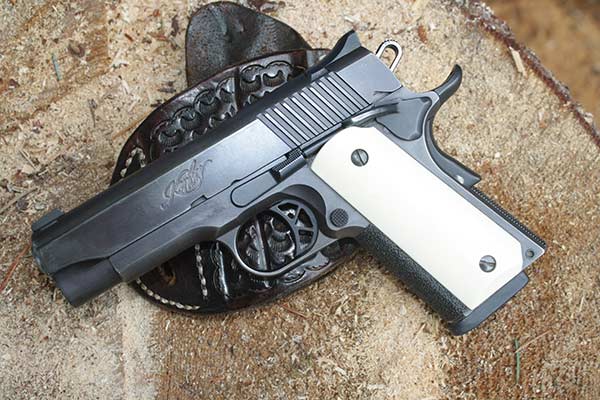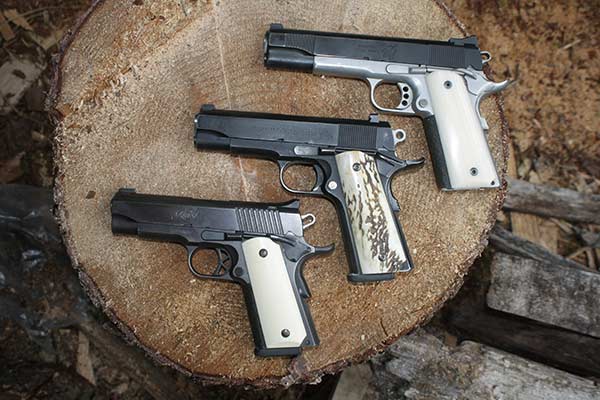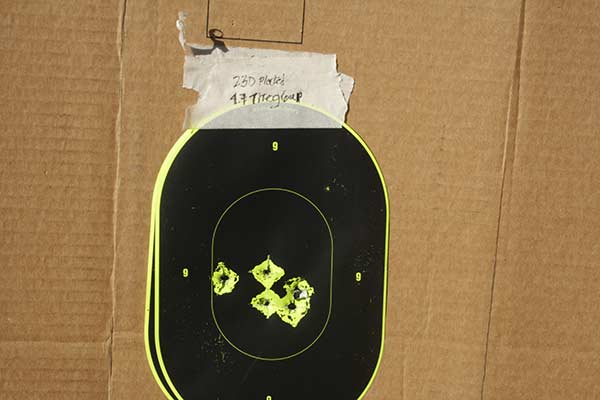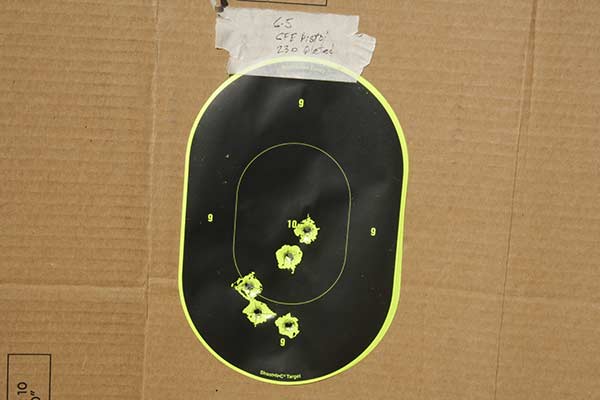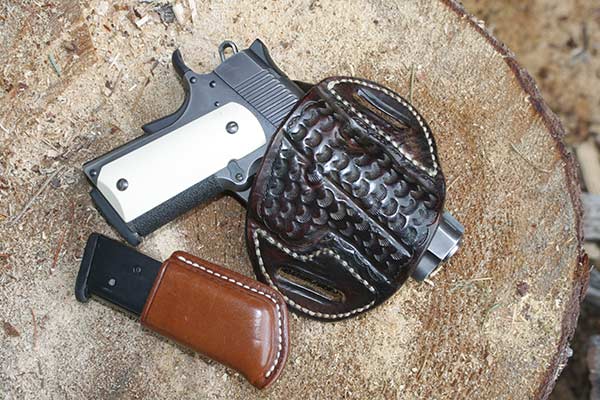An Old Friend
Dave Pulls His Kimber Out Of Mothballs
Sometimes it is good to shift gears, even when it comes to packing a defensive sidearm, so when I decided about six weeks ago to pull my Kimber Compact Custom out of mothballs — it was never meant to be a safe queen — and set aside my Commander for a while, it felt like the right thing to do.
The Kimber, built with an Officer’s Model grip frame and 4-inch bushingless barrel, topped with tritium sights, had been a test pistol more than 20 years ago. I liked it so much, I bought it. The pistol shot well enough at 15 and 25 yards using a variety of ammunition ranging from 185-grain JHPs to 230-grain FMJs, and for everyday concealed carry, the shorter grip seemed a good choice.
NOTE: What you are about to read can apply to virtually any compact variation of the Model 1911 platform. These are “social distance” guns, for improved concealment and “defensive range” shooting rather than in competition.
Easy enough to strip down, I brought the Kimber out of the safe where it has been resting quietly for a while, scrubbed out the barrel even though it was really not necessary, added a couple of drops of oil to the slide rails, and headed to the range. Just because a gun sits in a safe is no excuse for skipping regular maintenance.
Before we get too far into this, leading up to my decision was a reloading session in which I decided to shift away from my longtime favorite load of HP-38 behind a 230-grain FMJ for practicing and dealing with trail nastiness. Two other propellants were selected to fill a bunch of clean mixed brass I’d been keeping in a box for just such an occasion.
In addition, I dug into my healthy supply of plated 230-grainers from the old Rainier Ballistics (when it closed shop a couple of years ago, I had the good fortune to acquire several hundred of these bullets, plus some 200-grain pills), and I’m happy to report they shoot pretty well.
My propellant choices were Hodgdon’s Titegroup (4.7 grains)* and CFE Pistol (6.5 grains)*, neither loaded to the max, but stout enough to deliver what I expected out of the 4-inch barrel at social distances.
Plated bullets are nothing new. My first experience with plated pills came several years ago when Speer started producing them, and they were terrific. From that moment forward, I’ve been sold on plated bullets for my .45 ACP practice and trail loads. Back in my competition days, they performed without a flaw over the aforementioned HP-38, but since I was trying something different, the alternate powders were selected. I wasn’t disappointed.
Disclaimer: Always consult reloading manuals for up-to-date recommendations and approach any loads with caution.
Shorter = Slower
As is typical when running loads through a shorter barrel neither propellant delivered the kind of muzzle velocities one finds in loading manuals, and I’m okay with that. As Wyatt Earp is supposed to have said, “Fast is Fine, but Accuracy is Final.”
From 15 yards, both loads shot a bit low, which I attributed largely to my need to re-familiarize myself with this little powerhouse from Kimber. When I bought the pistol, it came with factory checkered rubber grips, which I quickly replaced with snazzy ivory polymer panels. At the time, I also added a strip of skateboard tape to the front of the grip frame, which has come in handy on days when I either had a sweaty palm or was shooting in the rain. Nobody ever guaranteed that emergencies will only happen in perfect weather conditions!
But the groups were adequately tight for my purposes. Of the two loads, the Titegroup-charged cartridges produced slightly tighter groups; certainly appropriate to the name of this powder. It also delivered the slower average velocities with my chronograph set 30 inches ahead of the muzzle.
My CFE Pistol-stoked rounds crossed the screens 20- to 30-fps faster, but shot a tad wider. It’s okay, of course, because in an emergency they would have all gone where they belonged and gotten someone’s or something’s immediate attention.
Of course, with a busy reloading press and plenty of brass availability, I’ll be able to keep this up well into the winter months without a hitch. I have a decent supply of large standard pistol primers, and I have hardly made a dent in the bullet supply.
Why Practice?
Seriously? Practice with a firearm — especially one upon which your life may one day depend — is imperative for any number of reasons, safety being my first choice.
Firearm familiarity is a must, which is why you will see guys like me, who write about guns, spending lots of time with our own firearms just to, as one of my mentors used to say, “keep my finger tuned.” Competency is my second most important reason, which runs right next to safety in my book.
So, when the decision was made to start packing the Kimber, more than just a casual thought went into it.
Of course, it’s one of the smaller of the 1911-type pistols around, but that doesn’t make this classic Kimber an also-ran. The magazine holds 7 rounds and with one up the spout, you’ve got eight doses of disaster prevention at your disposal. I’ve always considered losing a gunfight to be a disaster, don’t you?
Easy Packing
Not long after purchasing the pistol, I knocked together an IWB rig, in which the pistol rode for a long time. The IWB holster is a superb concealment choice because it hides so well even under a shorter cover garment, such as the denim jackets I often wear.
But a few years ago, I put together a pancake-type open-toe holster in which I can alternately carry a Commander or even a Government Model. It holds the butt of the gun in tight and securely, even though there’s no safety strap.
Because of its shorter slide and barrel, the Kimber Compact Custom rides virtually unnoticed under a cover garment. I carry a spare magazine in a single mag pouch from Milt Sparks, and I can always slip a second spare into my vest or jacket pocket.
Never underestimate the capabilities of a compact pistol. Good ones, regardless of caliber, can be remarkably accurate for their design. While they may not be target-grade sidearms, they can put rounds into a target reliably.
Capture The Flag
Late in August, the Second Amendment Foundation lit things up when it announced a federal challenge to Maryland’s so-called “red flag” law and opened the possibility of lawsuits challenging similar laws in five other states: California, Florida, Massachusetts, New Jersey and Washington.
SAF Executive Director Adam Kraut — himself a practicing attorney — said the “Capture the Flag” initiative will challenge laws that deprive individuals of their right to keep and bear arms, where appropriate, “based on evidentiary standards that are constitutionally impermissible.”
The Maryland lawsuit focuses on a case in Dorchester County against what SAF founder and Executive Vice President Alan Gottlieb called “an egregious abuse of the law.”
In a prepared statement, Kraut asserted the “fundamental flaw” in all of these laws is that they essentially consider people guilty until they prove themselves innocent. He said the concept is “diametrically opposed to the way our criminal justice system is supposed to work, where the burden of proof is on the state, not the individual.”
“When any citizen is unjustly deprived of his or her rights, it is an affront to all of us,” Kraut stated, “and we must do whatever we can to prevent it, including challenging such laws in federal court. ‘Capture the Flag’ provides the means for us to seek out such cases and take appropriate action.”
SAF is encouraging people residing in California, Florida, Maryland, Massachusetts, New Jersey, or Washington that have been “subject to a baseless, groundless and unsubstantiated Extreme Risk Protection Order (“Red Flag”) to contact the organization by sending an email to [email protected] with information regarding the circumstances surrounding the petition, order, and outcome.

